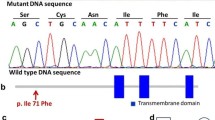Abstract
We report fives sporadic cases of hyperekplexia or startle disease characterized by a highly exaggerated startle reflex and tonic attacks. Affected neonates suffer from prolonged periods of stiffness and are at risk for sudden death from apnea. An early diagnosis is needed. Sudden loud sounds, unexpected tactile stimuli or percussion at the base of the nose can also elicit excessive jerking or tonic attack. The diagnosis of hyperekplexia is a purely clinical one. A defect of the alpha1 subunit of inhibitory glycine receptor (GLRA1) has been observed in the dominant form with a mutation in the chromosome 5. Clonazepam is effective and decreases the severity of the symptoms. The disease tends to improve after infancy and the psychomotor development is normal. The major form of “hyperekplexia” should be considered whenever one is confronted with neonatal hypertonicity associated with paroxysmal tonic manifestations (without electroencephalography anomalies). Conclusion: the diagnosis of hyperekplexia should be evaluated in any neonate with tonic attacks without evident cause.
Similar content being viewed by others
Abbreviations
- CRP:
-
C reactive protein
- EEG:
-
Electroencephalography
- HC:
-
Head circumference
- PMD:
-
Psychomotor development
- RMI:
-
Resonance magnetic imagery
References
Altunbasak S, Baytok A (1996) Startle disease: two sibling cases. Seizure 5:313–315
Andermann F, Andermann E (1988) Startle disorders of man, hyperekplexia, jumping and startle epilepsy. Brain Develop 10(4):213–221
Andermann F, Keene DL, Andermann E, Quesney LF (1980) Startle disease or hyperekplexia: future delineation of the syndrome. Brain 103:985–997
Becker E, Sutherland GR, Schofiel PR (1994) Localisation of the glycine receptor gene (GLRA1) to chromosome 5q32 by fish. Genomics 22:491–493
Bernasconi A, Régli F, Schorderet DF, Pescia G (1996) Hyperekplexia familiale: la maladie du sursaut. Rev Neurol 152(6–7):447–450
Brown P, Rothwell JC, Thompson TC, Britton TC, Day BL, Marsen CD (1991) The hyperekplexia and their relationship to the normal startle reflex. Brain 14:1903–1928
Dias Gherpelli JL, Nogueira Jr AR, Troster EJ, Daghostinho Deutsch A, Rodrigues Leone C, Wilson Iervolino Brotto M, Diament A, Aaraujo Ramos JL (1995) Hyperekplexia, a cause of neonatal apnea: a case report. Brain Develop 17:114–116
Elmslie FV, Hutchings SM, Spencer V, Curtis A, Covanis T, Gardiner RM, Rees M (1996) Analysis of GLRA1 in hereditary and sporadic hyperekplexia: a novel mutation in a family cosegregating for hyperekplexia and spastic paraparesis. J Med Genet 33:435–436
Gastaud H, Villeneuve A (1967) The startle disease or hyperekplexia: pathological surprise reaction. J Neurol Sci 5:523–542
Golbert SL, Ozdag F, Ulas UH, Dobyns WB, Lahn BT (2004) Hereditary hyperekplexia caused by novel mutations of GLRA1 in Turkish families. Mol Diagn 8(3):151–155
Lobera E, Campistol J, Garcia-Garcia JJ, Colomer J, Riverola A (1997) Congenital hyperekplexia as a cause of neonatal hypertonia. Rev Neurol 25(137):86–88
Nigro MA, Lim HC-N (1989) Hyperekplexia and sudden neonatal death. Pediatr Neurol 8(3):221–225
Oguro K, Hirano K, Aiba H (2005) Trigeminally induced startle in children with hyperekplexia. Mov Disord 20(4):484–489
Praveen V, Patole SK, Whitehall JS (2001) Hyperekplexia in neonates. Postgrad Med J 77(911):570–572
Ryan SG, Sherman SL, Terry JC, Sparkes RS, Torres C, Mackey RW (1992) Startle disease, or hyperekplexia response to clonazepam and assignment of the gene (STHE) to chromosome 5q by linkage analysis. Ann Neurol 31(6):663–667
Scarcella A, Coppola G (1997) Neonatal sporadic hyperekplexia: a rare and often unrecognized entity. Brain Develop 19(3):226–228
Sechi G, Sotgiu S, Valenti MP, Pitzolu MG, Peterlongo P, Larizza L, Rosati G (2000) Beneficial effect of fluorexine in a case of sporadic hyperekplexia. Clin Neuropharmacol 23(3):161–163
Shiang R, Ryan SG, Zhu YZ, Fielder TJ, Allen RJ, Fryer A, Yamashita S, O'Connell P, Wasmuth JJ (1995) Mutational analysis of familial and sporadic hyperekplexia. Ann Neurol 38:85–91
Shiang R, Ryan SG, Zhu YZ, Hahn AF, O'Connell P, Wasmuth JJ (1993) Mutation in the alpha 1 subunit of the inhibitory glycine receptor cause the dominant neurologic disorder, hyperekplexia. Nat Genet 5:351–357
Suhren O, Bruyn GW, Tuynman JA (1966) Hyperekplexia: a hereditary startle syndrome. J Neurol Sci 3:577–605
Tijssen MAJ, Shiang R, van Deutekom J, Boerman RH, Wasmuth JJ, Sandkuijl LA, Frants RR, Padberg GW (1995) Molecular genetic reevaluation of the Dutch hyperekplexia family. Arch Neurol 52:578–582
Tijssen MAJ, Voorkamp LM, Padberg GW, Gert Van Dijk J (1997) Startle responses in hereditary hyperekplexia. Arch Neurol 54:388–393
Tsai CH, Chang FC, Su YC, Tsai FJ, Lu MK, Lee CC, Kuo CC, Yang YW, Lu CS (2004) Two novel mutations of the glycine receptor gene in a Taiwanese hyperekplexia family. Neurology 63(5):893–896
Vigevano F, Di Capua M, Dalla-Bernardina B (1989) Startle disease: an available cause of sudden infant death. Lancet 28(8631):216
Zhou L, Chillag KL, Nigro MA (2002) Hyperekplexia: a treatable neurogenetic disease. Brain Develop 24(7):669–674
Author information
Authors and Affiliations
Corresponding author
Rights and permissions
About this article
Cite this article
Rivera, S., Villega, F., de Saint-Martin, A. et al. Congenital hyperekplexia: five sporadic cases. Eur J Pediatr 165, 104–107 (2006). https://doi.org/10.1007/s00431-005-0015-x
Received:
Accepted:
Published:
Issue Date:
DOI: https://doi.org/10.1007/s00431-005-0015-x




